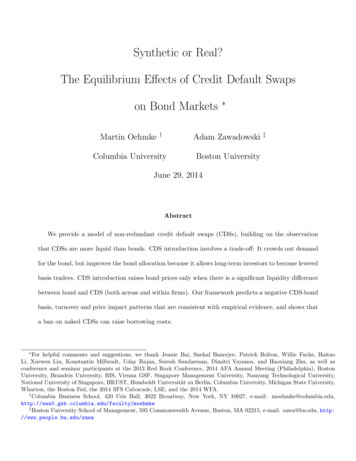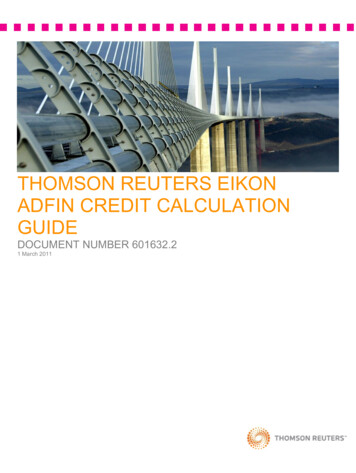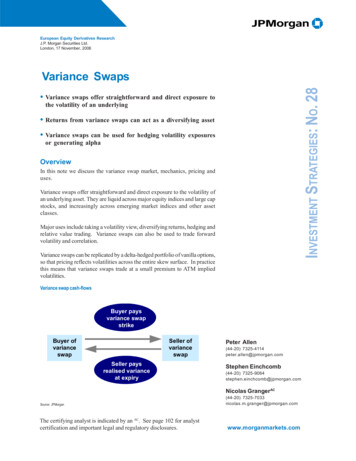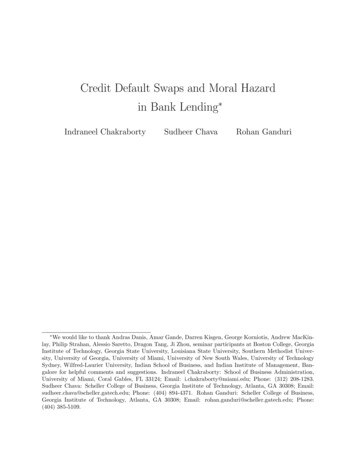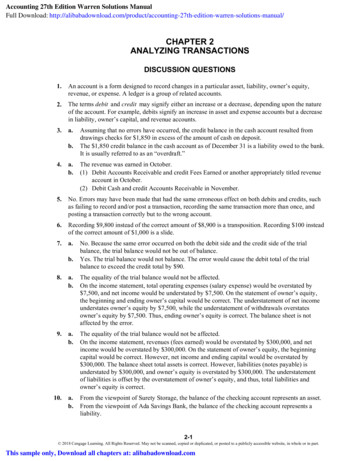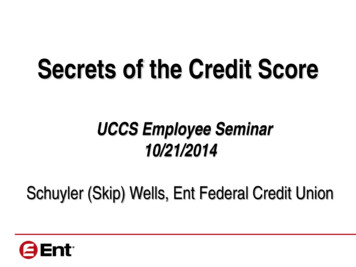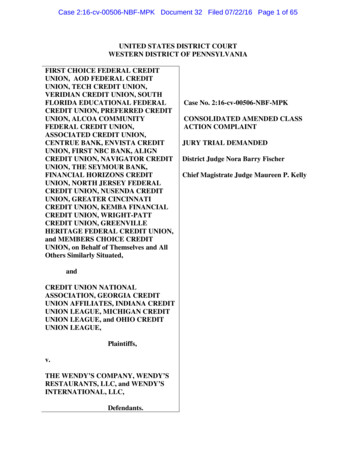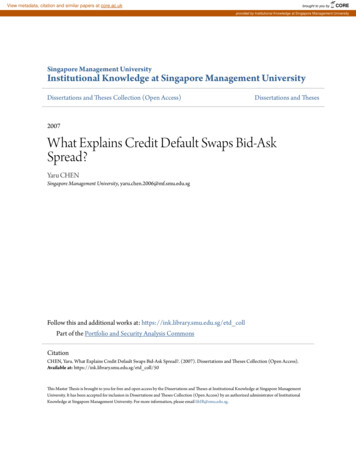
Transcription
View metadata, citation and similar papers at core.ac.ukbrought to you byCOREprovided by Institutional Knowledge at Singapore Management UniversitySingapore Management UniversityInstitutional Knowledge at Singapore Management UniversityDissertations and Theses Collection (Open Access)Dissertations and Theses2007What Explains Credit Default Swaps Bid-AskSpread?Yaru CHENSingapore Management University, yaru.chen.2006@mf.smu.edu.sgFollow this and additional works at: https://ink.library.smu.edu.sg/etd collPart of the Portfolio and Security Analysis CommonsCitationCHEN, Yaru. What Explains Credit Default Swaps Bid-Ask Spread?. (2007). Dissertations and Theses Collection (Open Access).Available at: https://ink.library.smu.edu.sg/etd coll/50This Master Thesis is brought to you for free and open access by the Dissertations and Theses at Institutional Knowledge at Singapore ManagementUniversity. It has been accepted for inclusion in Dissertations and Theses Collection (Open Access) by an authorized administrator of InstitutionalKnowledge at Singapore Management University. For more information, please email libIR@smu.edu.sg.
WHAT EXPLAINS CREDIT DEFAULT SWAPSBID-ASK SPREAD?CHEN YARUSINGAPORE MANAGEMENT UNIVERSITY2007
WHAT EXPLAINS CREDIT DEFAULT SWAPSBID-ASK SPREAD?CHEN YARUSUMITTED IN PARTIAL FULFILLMENT OFTHE REQUIREMENTS FOR THE DEGREE OFMASTER OF SCIENCE IN FINANCESINGAPORE MANAGEMENT UNIVERSITY2007ii
2007Chen YaruAll Rights Reservediii
What Explains Spread Credit Default Swaps Bid-Ask Spread?Chen YaruAbstractThe pace at which the Credit default swaps (CDS) has been growing since itsinception topped all projections. Despite the rapid growth, there is still room forenhancement of liquidity in the CDS market. Asymmetric information is anotherconcern of investors in CDS market, however, some literature addressed that it may notbe as serious as regarded. Bid-ask spreads is commonly used as a proxy of both liquidityand asymmetric information. Our empirical study confirms that CDS bid-ask spread hasexplanatory power to CDS premium. We then investigate the liquidity component inCDS bid-ask spreads. We use the bond age, bond amount, and bond time-to-maturity asthe liquidity measure. We confirm that the bond market and CDS market are closelycorrelated. However, the composition of CDS bid-ask spread need to be further studied.Key Words: Credit Default Swaps; Bid-Ask Spread; Liquidityiv
Table of Content1. Introduction. v2. Credit Default Swaps. 43. Related Literature . 74. Sample and Data . 145. Empirical Methodology. 175.1 CDS Bid-ask Spread and CDS Premium. 175.2 CDS Bid –ask Spread and Liquidity Measure . 196. Empirical Results. 247. Conclusion and limitation . 27Appendix A: CDS data from Bloomberg. 54Appendix B: Corporate Entities in Our Sample. 54Note: . 30Reference . 33i
List of TablesTable 1 CDS B/A Spread Summary Statistics. 37Table 2 Summary Statistics . 38Table 3 Correlations . 40Table 4 Relationship between Change in CDS and Change in Bid-ask Spread. 41Table 5 Long-Run Relationship between CDS Price and CDS Bid-ask Spread . 44Table 6 Cross-Sectional Method . 48ii
List of FiguresFigure 1 Global Credit Derivatives Market in bn of Notional Amount . 51Figure 2 Credit Derivatives Products (in Notional Amount). 51Figure 3 Rating of Underlying CDS (in percentage of Notional Amount) . 52Figure 4 Mean CDS Bid/Ask Spread (bp). 52Figure 5 Time Series of Credit Basis (bp) . 53Figure 6 Means of the Variables in Rating Groups . 53iii
AcknowledgementsA journey is easier when you travel together. This thesis is the result of one year ofwork whereby I have been accompanied and supported by many people. It is a pleasureto thank the many people who made this thesis possible.It is difficult to overstate my gratitude to my supervisor, Prof. Wu Chunchi. With hisenthusiasm, inspiration, and great efforts to explain things clearly and simply, he guidesme into the world of CDS. Throughout my thesis-writing period, he providedencouragement, sound advice, and lots of good ideas. I would have been lost withouthim.I am deeply indebted to Prof. Hai Lin from Xiamen University whose help,stimulating suggestions and encouragement helped me throughout the process ofcompleting this thesis.I would also like to gratefully acknowledge the support of some very specialindividuals. They helped me immensely by giving me encouragement and friendship.They mirrored back my ideas so I heard them aloud, an important process for this writerto shape this thesis and future work. Zhong Zhuo, Lee Yen Teik, Lin Ying Kui, XuJincai and Nathaniel. Thank you very much for all your kind helps.iv
1. IntroductionCredit derivatives have emerged as a remarkable and rapidly growing area in globalderivatives and risk management practice which have been perhaps the most significantand successful financial innovation of the last decade. The growth of the global creditderivatives market continues to outstrip expectations. According to BBA (BritishBankers’ Association) Credit Derivatives Report 2006, the outstanding notional amountof the market will be 20 trillion by the end of 2006 and will reach 33 trillion at the endof 2008 (see Figure 1). Single-name credit default swaps (CDS) still represent asubstantial proportion of the market, though the share has fallen to a third (see Figure 2).CDS are the most liquid products among the credit derivatives currently traded whichmake up the bulk of trading volume in credit derivatives markets. Moreover, CDS alongwith total return swaps and credit spread options are the basic building blocks for morecomplex structured credit products 1. The majority of underlying CDS are rated at A andBBB (see Figure 3). The Office of the Comptroller of the Currency reports a 20%quarterly growth rate in the notional amount of credit derivatives, where CDS represent97% of the total amount. The CDS market has supplanted the bond market as theindustry gauge for a borrower's credit quality.The remarkable growth of the CDS market not only attracts investors but also drivesexpanding academic studies on CDS. There has been a burgeoning literature thatdocuments the pricing of CDS. Similar to other financial instruments, there are twoapproaches to price CDS, which are reduced-form models and structural-form models.1
Structural-form models, whilst far from straightforward mathematically, are moregrounded in economic fundamentals than reduced-form models and thus form a goodstarting point for a realistic description of credit dynamics. However, there are largediscrepancies between the predictions of structural-form models and the observed creditspreads, which is also known as the credit premium puzzle (Amato and Remolona, 2003).Research has been done on calibrations that incorporate many realistic economicconsiderations 2. For example, Huang and Huang (2003) calibrate a wide range ofstructural models to be consistent with the data on historical default and loss experience.The reduced-form model developed by Hull and White (2000) is commonly accepted inpricing derivatives.Since CDS is designed to transfer credit risk, its price is regarded as a good measureof credit risk. Hence, the arbitrage opportunity between CDS price and credit spread ofbonds is also being studied widely (Zhu, 2004, etc.). From another point of view, CDStends to be more sensitive to credit events by design and a large portion of the users areregarded as informed traders. Information transfer efficiency and price discovery effects,in particular, are issues of considerable interest. Blanco et al. (2005) test the theoreticalequivalence of credit default swap spreads and credit spreads derived by Duffie (1999).Their empirical evidence strongly supports the parity relation as an equilibriumcondition. However, dynamic deviations are observed in the short run, which indicatesthat CDS spreads lead credit spreads in the process of price discovery process. Acharyaand Johnson (2007) examine the issue of the insider trading in CDS. They findsignificant incremental information revelation in the CDS market under circumstances2
consistent with the use of non-public information by informed banks. However, thedegree of asymmetric information does not adversely affect prices or liquidity in eitherthe equity or credit markets in their empirical study. Tang and Yan (2006) systematicallystudy the effects of liquidity in the CDS market and liquidity spillover from othermarkets on CDS spreads. Trading credit basis is a common strategy being used. Animportant consideration for investors trading the basis is an acceptable level of tradingvolume in the CDS market. Given that a reasonable amount of liquidity in CDS is aprerequisite for the development of more advanced structured products, the promotion oftransparency and liquidity in the CDS space has been a key objective for marketparticipants across the board.It is observed that the CDS bid-ask spread has declined over time with the growth ofCDS market (see Figure 4). This is probably due to the exponential growth of CDSmarket. Bid-ask spread of equities are commonly used as liquidity proxy. However, bidask spread is a noisy proxy of liquidity since it is also affected by asymmetricinformation. It is interesting to decompose the bid-ask spread to identify its determinants.The lack of study on CDS bid-ask spread is the result of data availability, which restrainsthe research on this topic. As derivatives are based on its fundamentals and as theinformation base and liquidity of CDS market have close relationships with both stockmarkets and bond markets, this study examines the determinants of CDS bid-ask spreadby employing cross-sectional method.Empirical results show that bond liquidity measures have significant explanatorypower to CDS bid-ask spread. It has been observed that from mid-2004, the CDS bid-ask3
spread dropped to a very low level. Recently, the credit basis is narrower as the marketmatures (see Figure 5), which also shows signs that the bond market and CDS marketare becoming more closely related. Our results show that the relationship between bondliquidity measure and CDS bid-ask spread does not change over time.Consistent with previous literature, our empirical results show that there is a positiverelationship between CDS bid-ask spread and leverage ratio, a negative relationshipbetween CDS bid-ask spread and firm size, as well as a positive relationship betweenCDS bid-ask spread and option implied volatility. A positive relationship between theliquidity of CDS and the liquidity of bond market has been found using bondoutstanding amount as liquidity proxy. However, this positive relationship is not so clearwhen use bond age or bond time-to-maturity as liquidity proxies. Data limitation is still achallenge of our study. The composition of CDS bid-ask spread requires further study.Anyway, we confirm the significant relationship between the CDS bid-ask spread andbond liquidity measure.The rest of this paper is organized as follows: Section 2 provides some backgroundinformation on the CDS market. Section 3 covers the literature reviews. Section 4describes the data used for this study. Section 5 discusses the method used for ourempirical analysis. Section 6 demonstrates the empirical results. Section 7 conclusionand limitation.4
2. Credit Default SwapsCredit default swaps are structured as instruments which make an agreed payoff uponthe occurrence of a credit event. In other words, in a CDS, the protection seller and theprotection buyer enter a contract which documents that the protection seller compensatesthe protection buyer if a default event occurs before maturity of the contract. If there isno default event before maturity, the protection seller pays nothing. In return, theprotection buyer typically pays a constant quarterly fee to the protection seller untildefault or maturity, whichever comes first. This quarterly payment, usually expressed asa percentage of its notional value, is the CDS spread or premium.The payment following the occurrence of a credit event is either repayment at paragainst physical delivery of a reference obligation (physical settlement) or the notionalprinciple minus the post default market value of the reference obligation (cashsettlement). In practice, physical settlement is the dominant settlement mechanism,though the proportion has dropped to 73% (according to BBA Credit Derivative Report2006). The delivery of obligations in case of physical settlement can be restricted to aspecific instrument, though usually the buyer may choose from a list of qualifyingobligations, irrespective of currency and maturity as long as they rank pari passu with(have the same seniority as) the reference obligation. This latter feature is commonlyreferred to as the cheapest-to-deliver option. Theoretically, all deliverable obligationsshould have the same price at default and the delivery option would be worthless.However, in some credit events, e.g., a restructuring, this option is favorable to the buyer,5
since he can deliver the cheapest bonds to the seller. Counterparties can limit the valueof the cheapest-to-deliver option by restricting the range of deliverable obligations, e.g.,to non-contingent, interest-paying bonds.As with all other financial markets, the liquidity and efficiency of aligning buyers andsellers depends on consistent, reliable and understandable legal documentation. TheInternational Swaps and Derivatives Association (ISDA) has been a strong force instabilizing the uniformity of documentation of CDS products through the assistance andsupport of its members: primarily the dealer community. At this point, there are settledforms of template documents for single-name corporate CDS, basket trades or singlenames, and CDS on Commercial Mortgage-Backed Securities (CMBS) and ResidentialMortgage-Backed Securities (RMBS). In addition, a form of CDS on Asset-BackedSecurities (ABS) confirmation is near completion and is expected to be followed closelyby a form of index (CMBX and ABX) 3 confirmations. CDS on ABS and MortgageBacked Securities (MBS) are typically documented under an ISDA form pay-as-you-go(physical settlement) confirmation (the pay-as-you-go (PAUG) dealer form), which iswidely accepted in the marketplace.The Credit Definitions by ISDA allow specification of the following credit events:1. Bankruptcy.2. Failure to pay above a nominated threshold (say in excess of US 1 million)after expiration of a specific grace period (say, 2 to 5 business days).3. Obligation default or obligation acceleration.4. Repudiation or moratorium (for sovereign entities).6
5. Restructuring.There are significant issues in defining the credit events. This reflects theheterogeneous nature of credit obligations. In general, items 1, 2 and 5 are commonlyused as credit events in CDS for firms. Four types of restructuring have been given byISDA: full restructuring; modified restructuring (only bonds with maturity shorter than30 months can be delivered); modified-modified restructuring (restructured obligationswith maturity shorter than 60 months and other obligations with maturity shorter than 30months can be delivered); and no restructuring.CDS are actively traded on corporate, bank, and sovereign debt, and the typicalcontract is written on notional amounts of US 10 million with a five-year maturity 4.Most of the contracts are drawn to reference bonds by a single issuer, that is, singlename contracts. When contracts refer to multiple issuers, they are referred to as portfolionames. The most popular portfolio transaction is probably the first-to-default basket. Inthese contracts, protection is sold on a basket of credit default swaps. Payments areterminated when the first credit event occurs or after a fixed period of time.3. Related LiteratureThe rapidly expanding credit derivatives market has attracted the spotlight. A vastgrowth of literature has been devoted to the studies of CDS market. However, given theshort history of the credit derivatives market and the limited data availability, there hasbeen limited empirical work in this arena. The relatively small empirical literature has7
focused on the determinants of CDS spreads and their role in price discovery in thechanges of credit condition. Hull and White (2000) provide a methodology for valuingsingle name credit default swaps without considering counterparty default risk. Theyassume that default probabilities, interest rates, and recovery rates are independent. Thesensitivity test of expected recovery rate shows that the valuation of a vanilla CDS isrelatively insensitive to the expected recovery rate, while it is not the case for a binaryCDS 5. Hull and White (2001) extend their previous paper by taking account ofcounterparty default risk and allow the contingent on defaults by multiple referenceentities. Assuming that the creditworthiness of companies can be defined by creditindices, they argue that if the default correlation between the two parties is positive, thenthe default of the counterparty will result in a positive replacement cost for theprotection buyer. Their results show that the swap rates increase with credit indexcorrelation and the rates may differ by more than 10% when the protection seller’s creditrating decreases from AAA to BBB and the value of the credit index correlation is 0.6 orhigher 6.Houweling and Vorst (2005) implement a set of reduced-form models on market CDSquotes and corporate bond quotes. They find that the reduced-form model outperformsdirectly comparing bonds’ credit spreads to CDS spreads. They focus on the pricingperformance of the model and the choice of benchmark yield curve. They show thatswap or repo rates are better proxies for default-free interest rates relative to the treasuryrate. Their study empirically confirms that financial markets no longer regard Treasurybonds as the default-free benchmark. Hull et al. (2004) examine the relationship between8
CDS spreads and bond yields and research benchmark risk-free rates used byparticipants in the derivative market. They also show that swap rates have better“goodness-to-fit” when compared to risk-free rates. Their empirical evidence alsosuggests that CDS market anticipates credit rating announcements, especially negativerating events.Norden and Weber (2004) analyze the response of stock and CDS markets to ratingannouncements made by the three major rating agencies during the period 2000-2002.They find significant abnormal returns in both markets 60-90 days before actualdowngrades and reviews for downgrade. Both markets show a significant announcementwindow effect but no significant reaction afterwards. The CDS market reacts earlier thanthe stock market with respect to reviews for downgrade by S&P and Moody's.Blanco et al. (2005) test the theoretical equivalence of credit default swap spreads andcredit spreads derived by Duffie (1999). Their empirical evidence strongly supports theparity relation as an equilibrium condition. However, dynamic deviations are observed inthe short run, which indicates that CDS spreads lead credit spreads in the price discoveryprocess. For the 27 firms for which the equilibrium relation holds, the CDS marketcontributes on average around 80% of price discovery.Zhu (2006) not only examine the long-term pricing accuracy in the CDS marketrelative to the bond market, but also look into the underlying factors that explain theprice differentials and exploring the short-term dynamic linkages between the twomarkets in the context of a time series framework. The panel data study and the VECM9
analysis both suggest that short-term deviations between the two markets are largely dueto the higher responsiveness of CDS spreads to changes in credit condition.Longstaff et al. (2005) examine weekly lead-lag relationships between CDS spreadchanges, corporate bond spreads, and stock returns of US firms in a VAR framework.They find that both stock and CDS markets lead the corporate bond market whichprovides support for the hypothesis that information seems to flow first into creditderivatives and stock markets and then into corporate bond markets. However, there aremany exceptions to this rule of thumb. Moreover, in their sample there is no clear lead ofthe stock market with respect to the CDS market and vice versa.Most of the empirical studies focus on rating events, while Jorion and Zhang (2006)first document the intra-industry credit contagion effect using CDS and stock markets.They examine the information transfer effect of credit events across the industry, ascaptured by the CDS and stock markets. The empirical evidence strongly supports thedomination of contagion effects over competition effects for Chapter 11 bankruptciesand competition effects over contagion effects for Chapter 7 bankruptcies. The study ofjump event, which is a large jump in a company’s CDS spread, lead to the strongestevidence of credit contagion across the industry. Further, they show that contagioneffects are better captured in the CDS market than in the stock market.Zhang et al. (2006) include jump risks of individual firms to explain credit defaultswap spreads. They adopt both historical and realized measures as proxies for variousaspects of the jump risks. They use high-frequency equity returns of individual firms todetect the realized jumps on each day. They find empirical evidence to support that long-10
run historical volatility, short-run realized volatility, and various jump-risk measures allhave statistically significant and economically meaningful effects on credit spreads.More important, the sensitivities of credit spreads to volatility and jump risk are greatlydependent on the credit grade of the entities. Moreover, the relationship is nonlinear.Equity jump may affect credit spread in a nonlinear, asymmetric way; negative jumpstend to have larger effects. They calibrate a series of models—Merton (1974), jumpdiffusion, stochastic volatility, and jump-diffusion stochastic volatility (JDSV). Theircalibration results suggest that the adoption of the JDSV model can significantlyimprove the empirical performance of structural models. Nevertheless, the JDSV modelcannot completely resolve the credit premium puzzle.Berndt et al. (2006) investigate the source for common variation in the portion ofreturns observed in U.S. credit markets that is not related to changes in risk-free rates orexpected default losses. They extract a latent common component from firm-specificchanges in default risk premium that is orthogonal to known systematic risk factors from2001 to 2004. Asset pricing tests using returns on Bloomberg-NASD corporate bondindices suggest that latent changes in default risk premium (DRP) factor is priced in thecorporate bond market. A cross-sectional analysis of Merrill Lynch corporate bondportfolios sorted on either industry, maturity or rating supports these findings. They findcompelling support for common time-series variation in firm-specific changes in defaultrisk premia. Up to 42% of this co-movement can be due to exposure to other knownsources of common variation. They then develop a theoretical framework that, while theDRP factor is part of the pricing kernel, supports their empirical finding; a maximum of11
35% of the residual is explained by DRP factor. It shows that the DRP factor capturesthe jump-to-default risk associated with market-wide credit events. While they find thatDRP factor is priced in the market for corporate bonds, they find limited support for asimilar conclusion in the equity markets.There is very little literature that addresses the bid-ask spread of CDS price. Anexception is Acharya and Johnson (2007). They quantify insider trading in CDS marketby incremental information revelation in the CDS market using news in the stockmarkets as a benchmark for public information. They report evidence consistent with theoccurrence of informed revision of quotes. Information revelation in the CDS market isasymmetric. They show that the information flow from CDS market to the stock marketis greater for negative credit news and for entities that subsequently experience adverseshocks using a credit-condition dummy. Commercial banks that have an ongoing lendingrelationship with the company are identified as insiders. Using this as a proxy ofinformed insider, they find that the degree of information flow increases with thenumber of banks that have ongoing lending (and hence monitoring) relations with agiven entity. Robustness tests show that the relationship is not affected by noninformational trade, liquidity levels in the CDS and stock markets, and the level of riskof the credit. However, they find no evidence that the degree of insider activity, in theirframework, adversely affects prices or liquidity in either the equity or the credit markets.Moreover, they reported that the percentage bid-ask spread has no explanatory power forthe level of CDS prices. They find that the CDS market lead stock market in informationtransmission. Furthermore, their results suggest that trading restrictions on the activity of12
commercial banks, the potentially informed players in these markets, could result in areduction in the liquidity.Tang and Yan (2006) systematically study the effects of liquidity in the CDS marketand liquidity spillover from other markets on CDS spread using a large data set. Theyfind substantial liquidity spillover from bond, stock and option markets to the CDSmarket. To isolate the effects of liquidity and liquidity spillover, they control otherfundamental determinants of CDS spreads. Leverage ratio, asset volatility, jumpcomponent, book-to-market ratio and firm size are used as fundamental determinants.They find that systematic liquidity is priced beyond the liquidity level. They also findthat liquidity risk is more important for more active CDS while liquidity level is moreimportant for infrequently traded CDS.Data limitations pose a challenge to the quantification of liquidity in the CDS markets.It is nearly impossible to directly use proxies in the CDS markets to explain the bid-askspread of CDS quotes. To meet this challenge, we utilize the fact that the worth of CDSdepends primarily on the value of the underlying reference entity. Since all thecompanies in my sample have actively traded equity and option, we use fundamentalinformation of the entities. The credit condition of an entity can be largely measured byits firm size, leverage and volatility. Furthermore, Tang and Yan (2006) havedemonstrated liquidity spillover from other markets on CDS spreads. We use the totalamount of outstanding bonds, the age of outstanding bonds and the maturity of bonds tomeasure the basic liquidity characteristic of bonds to study whether they haveexplanatory power to the liquidity in CDS market.13
4. Sample and DataIn this paper, we include CDS quotes written on U.S. entities (excluding sovereignentities) and denominated in U.S. dollars. We eliminate the subordinate class of CDScontracts because there are relatively less CDS written on subordinate obligations. Wefocus on five-year single-name CDS contracts because they are most popular in the U.S.market 7. After matching the CDS data with other information, such as balance sheet andbond characteristic information (discussed later), we are left with 124 entities in ourstudy 8. This is a relatively large pool of entities as compared to other empirical studieson CDS.Our sample covers from June 2002 to April 2006. The entities must satisfy thefollowing requirements:(1) non-sovereign US entities(2) fundamental data are available from Compustat database(3) has at least 100 observations of CDS quotes and option implied volatility(4) bond issues information is available from Mergent Fixed Income SecuritiesDatabase (FISD)The CDS quotes are collected from Bloomberg terminal. The CDS data in Bloombergis from CMA DataVisionTM composite prices—prices that are sourced from the frontoffices of the leading investment banks, hedge funds and asset managers. More detailsabout the CDS quot
CDS bid-ask spreads. We use the bond age, bond amount, and bond time-to-maturity as the liquidity measure. We confirm that the bond market and CDS market are closely correlated. However, the composition of CDS bid-ask spread need to be further studied. Key Words: Credit Default Swaps; Bid-Ask Spread; Liquidity iv
